Brother MFC-7360, MFC 7860DW User Manual

BASIC USER’S GUIDE
MFC-7360
MFC-7460DN
MFC-7860DW
Version A
TWN-ENG
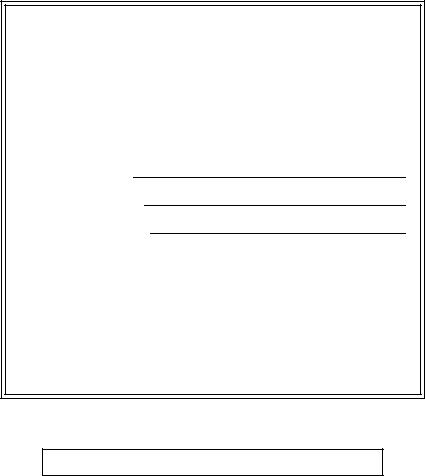
If you need to call Customer Service
Please complete the following information for future reference:
Model Number: MFC-7360, MFC-7460DN and
MFC-7860DW
(Circle your model number) Serial Number: 1
Date of Purchase:
Place of Purchase:
1The serial number is on the back of the unit. Retain this User’s Guide with your sales receipt as a permanent record of your purchase, in the event of theft, fire or warranty service.
Register your product on-line at
http://www.brother.com/registration/
© 2010 Brother Industries, Ltd.

User’s Guides and where do I find it?
|
|
|
Which manual? |
What’s in it? |
Where is it? |
Safety and Legal |
Read this Guide first. Please read the Safety |
For Chinese: Printed / In the box |
|
Instructions before you set up your machine. |
For Chinese English: PDF file / |
|
See this Guide for trademarks and legal |
|
|
Documentation CD-ROM / |
|
|
limitations. |
|
|
In the box |
|
Quick Setup Guide |
Follow the instructions for setting up your |
|
|
machine and installing the drivers and software |
|
|
for the operating system and connection type |
|
|
you are using. |
|
Basic User's Guide |
Learn the basic Fax, Copy and Scan |
|
|
operations and how to replace consumables. |
|
|
See troubleshooting tips. |
|
Advanced User's |
Learn more advanced operations: Fax, Copy, |
PDF file / |
Guide |
security features, printing reports, and |
Documentation CD-ROM / |
|
performing routine maintenance. |
In the Box |
Software User’s |
Follow these instructions for Printing, |
|
Guide |
Scanning, Network Scanning, Remote Setup, |
|
|
PC-Fax, and using the Brother ControlCenter |
|
|
utility. |
|
Network Glossary |
This Guide provides basic information about |
|
|
advanced network features of Brother |
|
|
machines along with explanations about |
|
|
general networking and common terms. |
|
Network User’s |
This Guide provides useful information about |
|
Guide |
wired and wireless network settings and |
|
|
security settings using the Brother machine. |
|
|
You can also find supported protocol |
|
|
information for your machine and detailed |
|
|
troubleshooting tips. |
|
|
|
|
i |
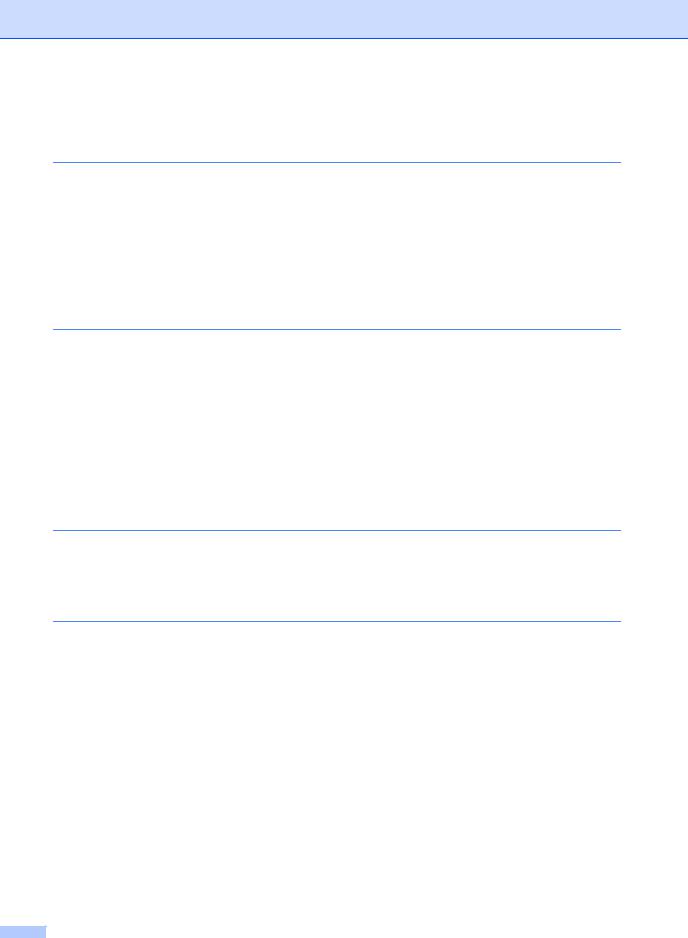
Table of Contents |
|
|
(BASIC USER’S GUIDE) |
|
|
1 |
General information |
1 |
|
Using the documentation ....................................................................................... |
1 |
|
Symbols and conventions used in the documentation .................................... |
1 |
|
Accessing the Advanced User's Guide, Software User's Guide and |
|
|
Network User's Guide......................................................................................... |
2 |
|
Viewing Documentation................................................................................... |
2 |
|
Accessing Brother Support (Windows®)................................................................ |
4 |
|
Accessing Brother Support (Macintosh) ................................................................ |
5 |
|
Control panel overview .......................................................................................... |
6 |
2 |
Loading paper |
9 |
|
Loading paper and print media .............................................................................. |
9 |
|
Loading paper in the standard paper tray........................................................ |
9 |
|
Loading paper in the manual feed slot .......................................................... |
11 |
|
Unscannable and unprintable areas.............................................................. |
16 |
|
Paper settings...................................................................................................... |
17 |
|
Paper Type .................................................................................................... |
17 |
|
Paper Size ..................................................................................................... |
17 |
|
Acceptable paper and other print media.............................................................. |
17 |
|
Type and size of paper .................................................................................. |
18 |
|
Handling and using special paper ................................................................. |
19 |
3 |
Loading documents |
22 |
|
How to load documents ....................................................................................... |
22 |
|
Using the automatic document feeder (ADF) ................................................ |
22 |
|
Using the scanner glass ................................................................................ |
23 |
4 |
Sending a fax |
25 |
|
How to send a fax ................................................................................................ |
25 |
|
Faxing Letter size documents from the scanner glass .................................. |
26 |
|
Canceling a fax in progress ........................................................................... |
26 |
|
Transmission verification report..................................................................... |
26 |
ii |
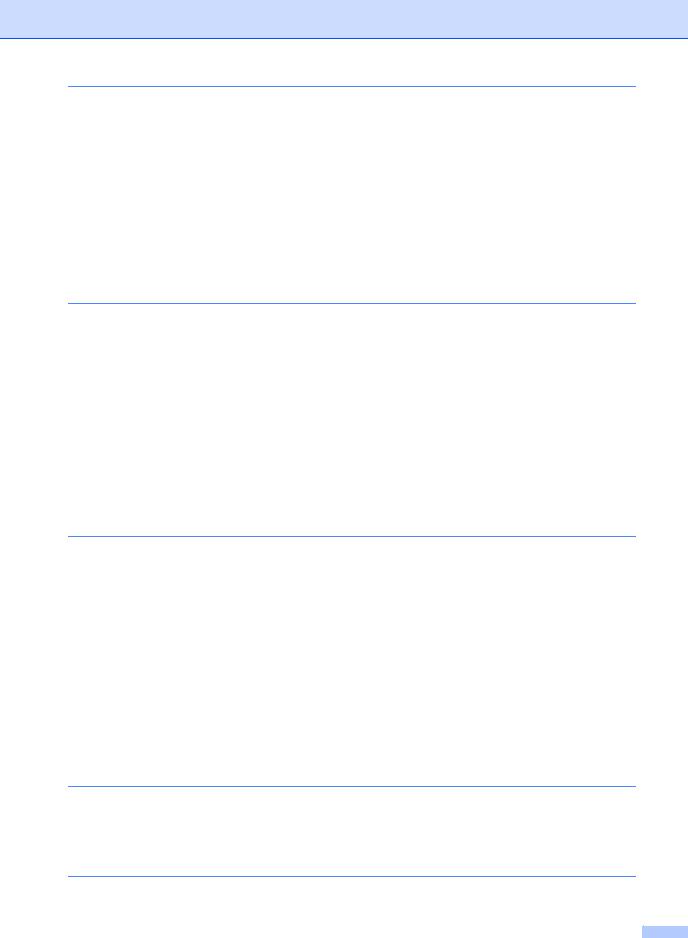
5 |
Receiving a fax |
27 |
|
Receive modes .................................................................................................... |
27 |
|
Choose the correct Receive Mode ................................................................ |
27 |
|
Using receive modes ........................................................................................... |
29 |
|
Fax Only ........................................................................................................ |
29 |
|
Fax/Tel........................................................................................................... |
29 |
|
Manual........................................................................................................... |
29 |
|
External TAD ................................................................................................. |
29 |
|
Receive Mode settings ........................................................................................ |
30 |
|
Ring Delay ..................................................................................................... |
30 |
|
F/T Ring Time (Fax/Tel mode only)............................................................... |
30 |
|
Easy Receive................................................................................................. |
31 |
6 |
Telephone services and external devices |
32 |
|
Telephone line services ....................................................................................... |
32 |
|
Voice Mail ...................................................................................................... |
32 |
|
Distinctive Ring.............................................................................................. |
32 |
|
Connecting an external TAD (telephone answering device)................................ |
35 |
|
Connections................................................................................................... |
35 |
|
Recording an outgoing message (OGM)....................................................... |
36 |
|
Multi-line connections (PBX) ......................................................................... |
36 |
|
External and extension telephones...................................................................... |
36 |
|
Connecting an external or extension telephone ............................................ |
36 |
|
Using external and extension telephones ..................................................... |
37 |
|
Using a non-Brother cordless external handset ............................................ |
37 |
|
Using Remote Codes .................................................................................... |
38 |
7 |
Dialing and storing numbers |
39 |
|
How to dial........................................................................................................... |
39 |
|
Manual dialing ............................................................................................... |
39 |
|
One touch dialing........................................................................................... |
39 |
|
Speed Dialing ................................................................................................ |
39 |
|
Search ........................................................................................................... |
40 |
|
Fax redial....................................................................................................... |
40 |
|
Storing numbers .................................................................................................. |
40 |
|
One Touch and Speed Dial Options.............................................................. |
41 |
|
Storing a pause ............................................................................................. |
42 |
|
Storing One Touch Dial numbers .................................................................. |
42 |
|
Storing Speed Dial numbers.......................................................................... |
44 |
|
Changing One Touch and Speed Dial numbers............................................ |
46 |
|
Deleting One Touch and Speed Dial numbers .............................................. |
47 |
8 |
Making copies |
48 |
|
How to copy ......................................................................................................... |
48 |
|
Stop copying.................................................................................................. |
48 |
|
Copy settings................................................................................................. |
48 |
9 |
How to print from a computer |
49 |
|
Printing a document............................................................................................. |
49 |
iii

10 |
How to scan to a computer |
50 |
|
Scanning a document as PDF file using ControlCenter4 (Windows®) ................ |
50 |
|
Changing the SCAN key settings ........................................................................ |
53 |
|
Before scanning............................................................................................. |
53 |
|
SCAN key settings......................................................................................... |
53 |
|
Scanning using the SCAN key ...................................................................... |
55 |
A |
Routine maintenance |
56 |
|
Replacing the consumable items......................................................................... |
56 |
|
Replacing the toner cartridge ........................................................................ |
57 |
|
Cleaning the corona wire............................................................................... |
62 |
|
Replacing the drum unit................................................................................. |
63 |
B |
Troubleshooting |
68 |
|
Error and maintenance messages....................................................................... |
68 |
|
Transferring your faxes or Fax Journal report ............................................... |
73 |
|
Document Jams................................................................................................... |
74 |
|
Document is jammed in the top of the ADF unit ............................................ |
74 |
|
Document is jammed under the document cover .......................................... |
74 |
|
Removing small documents jammed in the ADF........................................... |
75 |
|
Document is jammed at the output tray......................................................... |
75 |
|
Paper Jams.......................................................................................................... |
76 |
|
Paper is jammed in the standard paper tray.................................................. |
76 |
|
Paper is jammed at the back of the machine ................................................ |
77 |
|
Paper is jammed inside the machine............................................................. |
79 |
|
Paper is jammed in the Duplex Tray (MFC-7460DN and MFC-7860DW)..... |
84 |
|
If you are having difficulty with your machine ...................................................... |
86 |
|
Setting Dial Tone detection ........................................................................... |
95 |
|
Telephone line interference ........................................................................... |
95 |
|
Improving the print quality.................................................................................... |
96 |
|
Machine Information .......................................................................................... |
106 |
|
Checking the Serial Number........................................................................ |
106 |
|
Reset functions .................................................................................................. |
106 |
|
How to reset the machine............................................................................ |
107 |
C |
Menu and features |
108 |
|
On-screen programming.................................................................................... |
108 |
|
Menu table................................................................................................... |
108 |
|
How to access the menu mode ................................................................... |
108 |
|
Menu table ......................................................................................................... |
109 |
|
Entering text....................................................................................................... |
126 |
iv

D |
Specifications |
128 |
|
General.............................................................................................................. |
128 |
|
Document Size .................................................................................................. |
130 |
|
Print media......................................................................................................... |
131 |
|
Fax..................................................................................................................... |
132 |
|
Copy .................................................................................................................. |
133 |
|
Scanner ............................................................................................................. |
134 |
|
Printer ................................................................................................................ |
135 |
|
Interfaces........................................................................................................... |
136 |
|
Computer requirements .................................................................................... |
137 |
|
Consumable items ............................................................................................. |
139 |
|
Network (LAN) ................................................................................................... |
140 |
E |
Appendix |
141 |
|
Brother numbers ................................................................................................ |
141 |
F |
Index |
142 |
v |
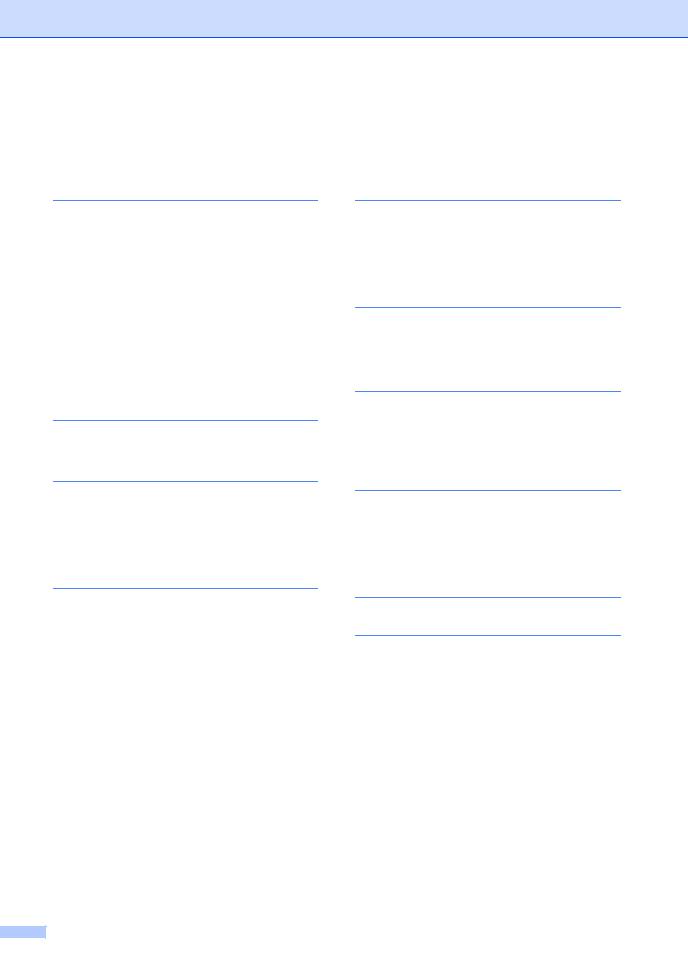
Table of Contents
(ADVANCED USER’S GUIDE)
The Advanced User's Guide explains the following features and operations. You can view the Advanced User's Guide on the Documentation CD-ROM.
1General Setup
Memory Storage Volume settings
Automatic daylight savings time Ecology features
Toner Settings LCD Contrast Dial Prefix Mode Timer
2Security features
Security
3Sending a fax
Additional sending options Additional sending operations Polling overview
4Receiving a fax
Remote Fax Options Additional receiving operations Polling overview
5Dialing and storing numbers
Telephone line services Additional dialing operations Additional ways to store numbers
6Printing reports
Fax reports Reports
7Making copies
Copy settings
Duplex Copying (1-sided to 2-sided) (For MFC-7460DN and MFC-7860DW)
ARoutine maintenance
Cleaning the machine Checking the machine
Packing and shipping the machine
BGlossary
CIndex
vi
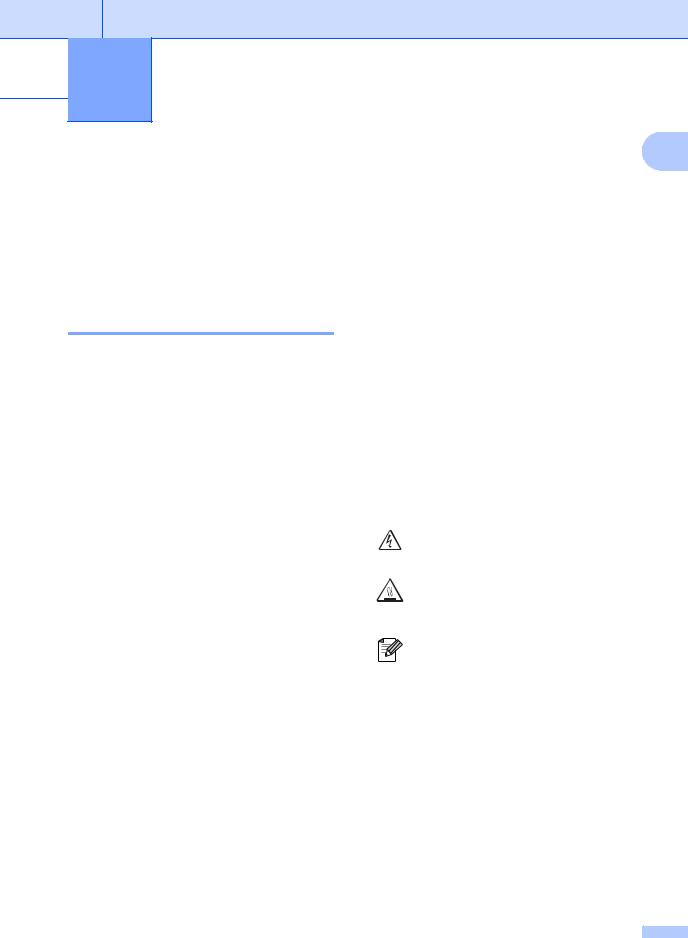
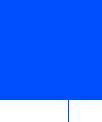 1 General information
1 General information
Using the documentation
1
 WARNING
WARNING
Thank you for buying a Brother machine! Reading the documentation will help you make the most of your machine.
WARNING indicates a potentially hazardous situation which, if not avoided, could result in death or serious injuries.
Symbols and conventions used in the documentation
The following symbols and conventions are used throughout the documentation.
Bold |
Bold style identifies keys on the |
|
machine control panel or |
|
computer screen. |
Italics |
Italicized style emphasizes an |
|
important point or refers you to |
|
a related topic. |
Courier |
Courier New font identifies the |
New |
messages shown on the LCD |
|
of the machine. |
 CAUTION
CAUTION
CAUTION indicates a potentially hazardous situation which, if not avoided, may result in minor or moderate injuries.
 IMPORTANT
IMPORTANT
IMPORTANT indicates a potentially hazardous situation which, if not avoided, may result in damage to property or loss of product functionality.
Electrical Hazard icons alert you to a possible electrical shock.
Hot Surface icons warn you not to touch machine parts that are hot.
Notes tell you how you should respond to a situation that may arise or give tips about how the current operation works with other features.
1 |

Chapter 1
Accessing the
Advanced User's
Guide, Software User's
Guide and Network
User's Guide
This Basic User's Guide does not contain all the information about the machine such as how to use the advanced features for Fax, Copy, Printer, Scanner, PC-Fax and Network. When you are ready to learn detailed information about these operations, read the Advanced User's Guide, Software
User's Guide, Network Glossary 1 and
Network User's Guide 1 that are on the Documentation CD-ROM.
1 Network models only
Viewing Documentation
a Turn on your computer. Insert the Documentation CD-ROM into your CD-ROM drive. For Windows® users, go to step c.
 Note
Note
(Windows® users) If the screen does not appear automatically, go to My Computer (Computer), double-click the CD-ROM icon, and then double-click index.html.
b (Macintosh users) Double-click the Documentation CD-ROM icon, and then double-click index.html.
c Click your country.
d Point to your language, point to View Guide, and then click the guide you want to read.
2 |

 Note
Note
• (Windows® users only) Your Web browser may display a yellow bar at the top of the page that contains a security warning about Active X controls. For the page to display correctly you must click on the bar, click Allow Blocked Content, then click
Yes in the Security Warning dialog box.
• (Windows® users only) 1 For faster access, you can copy all user documentation in PDF format to a local folder on your computer. Point to your language, then click Copy to local disk.
1 Microsoft® Internet Explorer® 6.0 or greater.
How to find Scanning instructions
There are several ways you can scan documents. You can find the instructions as follows:
Software User's Guide
Scanning
ControlCenter
Network Scanning (Network models only)
General information
Presto! PageManager User’s Guide
Note |
1 |
Presto! PageManager is available as a download from http://nj.newsoft.com.tw/download/brother/ PM9SEInstaller_BR_multilang.dmg/
The complete Presto! PageManager User’s Guide can be viewed from the Help selection in the Presto! PageManager application.
How to find Network setup instructions
(Network models only)
Your machine can be connected to a wireless or wired network. You can find basic setup instructions in the Quick Setup Guide. If your wireless access point or router supports Wi-Fi Protected Setup or AOSS™, you can also follow the steps in the Quick Setup Guide. For more information about network setup, please see the Network User's Guide.
3 |
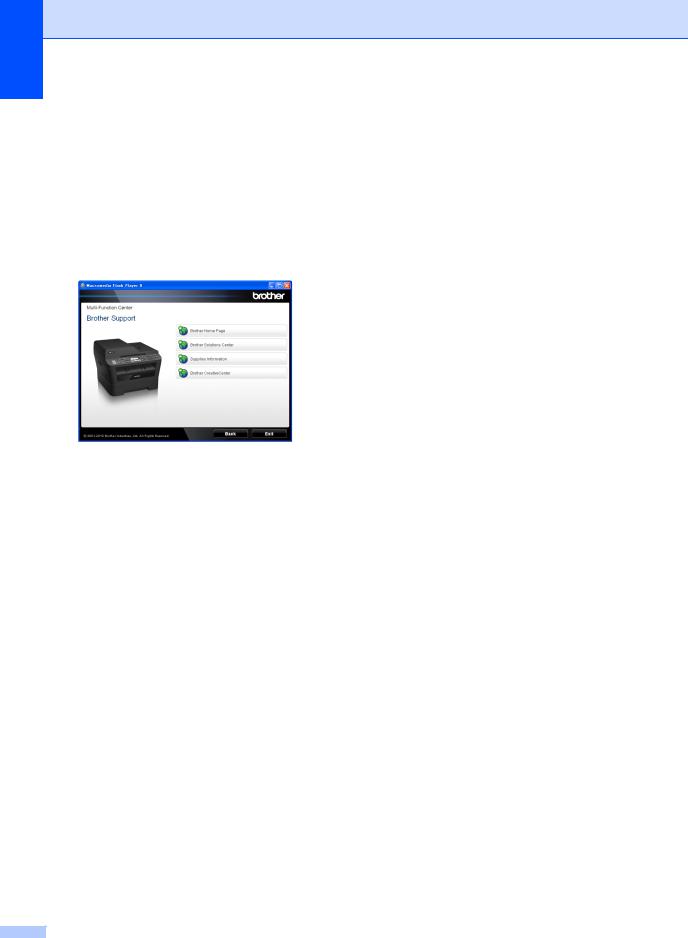
Chapter 1
Accessing Brother
Support (Windows®)
You can find all the contacts you will need, such as Web support (Brother Solutions Center) on the Installation CD-ROM.
Click Brother Support on the main menu. The following screen will appear:
To access our Web site (http://www.brother.com/) click Brother Home Page.
For the latest news and product support information (http://solutions.brother.com/), click
Brother Solutions Center.
To visit our Web site for genuine Brother supplies (http://www.brother.com/original/), click
Supplies Information.
To access the Brother CreativeCenter (http://www.brother.com/creativecenter/) for FREE photo projects and printable downloads, click Brother CreativeCenter.
To return to the main page, click Back.
Or, if you have finished, click Exit.
4
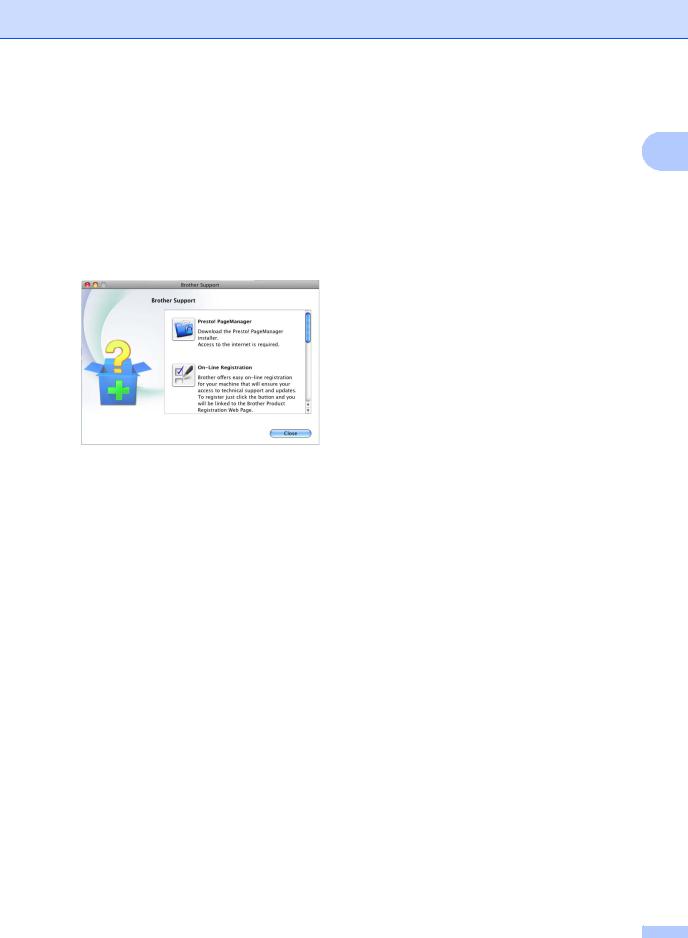
Accessing Brother
Support (Macintosh)
You can find all the contacts you will need, such as Web support (Brother Solutions Center) on the Installation CD-ROM.
Double-click the Brother Support icon. The following screen will appear:
To download and install Presto! PageManager, click Presto! PageManager.
To register your machine from the Brother Product Register Page (http://www.brother.com/registration/), click On-Line Registration.
For the latest news and product support information (http://solutions.brother.com/), click
Brother Solutions Center.
To visit our Web site for genuine Brother Supplies (http://www.brother.com/original/), click
Supplies Information.
General information
1
5 |
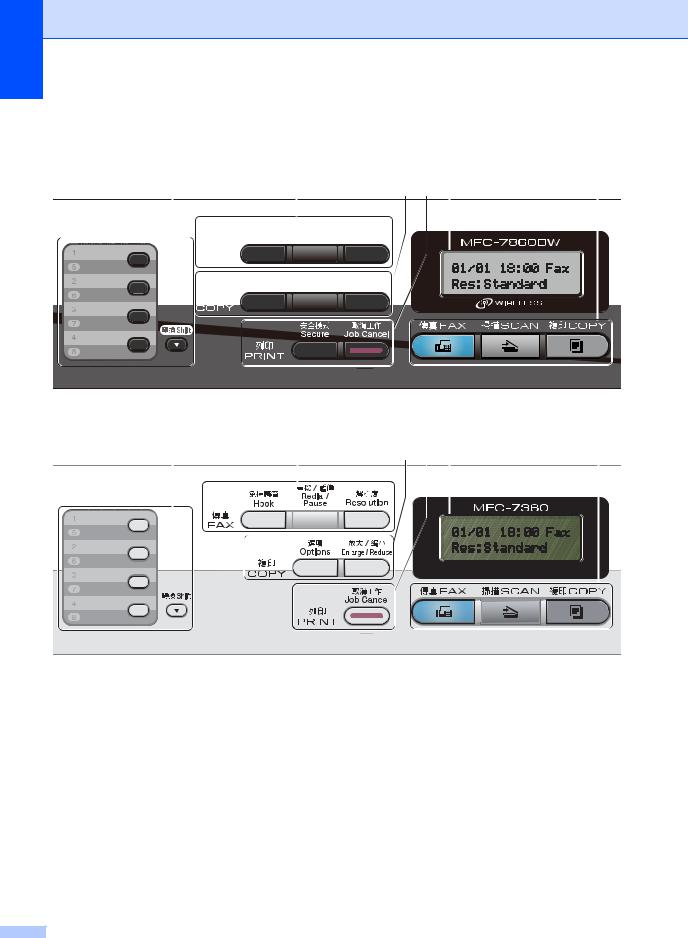
Chapter 1
Control panel overview
MFC-7460DN and MFC-7860DW have the same keys.
1 |
|
2 |
3 |
4 |
5 |
|
6 |
||||||
|
|
|
|
|
|
|
|
|
|
|
|
|
|
|
|
|
|
|
|
|
|
|
|
|
|
|
|
|
|
|
|
|
|
|
|
|
|
|
|
|
|
|
|
|
|
|
|
|
|
|
|
|
|
|
|
|
|
|
|
|
|
|
|
|
|
|
|
|
|
|
|
|
|
|
|
|
|
|
|
|
|
|
|
|
|
|
|
|
|
|
|
|
|
|
|
|
|
|
|
|
|
|
|
|
|
|
|
|
|
|
|
|
|
|
|
|
|
|
|
|
|
|
|
|
|
|
|
|
|
|
|
|
|
|
|
|
|
|
|
MFC-7360
1 |
|
2 |
|
|
3 |
4 |
5 |
|
6 |
|||||||||||
|
|
|
|
|
|
|
|
|
|
|
|
|
|
|
|
|
|
|
|
|
|
|
|
|
|
|
|
|
|
|
|
|
|
|
|
|
|
|
|
|
|
|
|
|
|
|
|
|
|
|
|
|
|
|
|
|
|
|
|
|
|
|
|
|
|
|
|
|
|
|
|
|
|
|
|
|
|
|
|
|
|
|
|
|
|
|
|
|
|
|
|
|
|
|
|
|
|
|
|
|
|
|
|
|
|
|
|
|
|
|
|
|
|
|
|
|
|
|
|
|
|
|
|
|
|
|
|
|
|
|
|
|
|
|
|
|
|
|
|
|
|
|
|
|
|
|
|
|
|
|
|
|
|
|
|
|
|
|
|
|
|
|
|
|
|
|
|
|
|
|
|
|
|
|
|
|
|
|
|
|
|
|
|
|
|
|
|
|
|
|
|
|
|
|
|
|
|
|
|
|
|
|
|
|
|
|
|
|
|
|
|
|
|
|
|
|
|
|
|
|
|
|
|
|
|
|
|
|
|
|
|
|
|
|
|
|
|
|
|
|
|
|
|
|
|
|
|
|
|
|
|
|
|
|
|
|
|
|
|
|
|
|
|
|
|
|
|
|
|
|
|
|
|
|
|
|
|
|
|
|
|
|
|
|
|
|
|
|
|
|
|
|
|
|
|
|
|
|
|
|
|
|
|
|
|
|
|
|
|
|
|
|
|
|
6 |
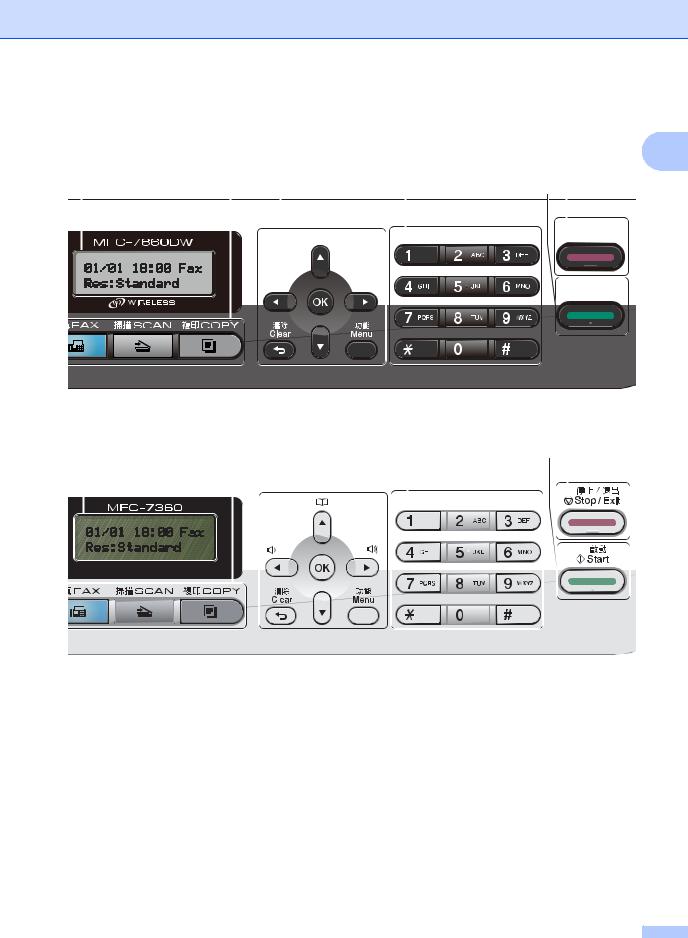
General information
1
5 |
|
6 |
7 |
8 |
|
9 10 |
|||||||||
|
|
|
|
|
|
|
|
|
|
|
|
|
|
|
|
|
|
|
|
|
|
|
|
|
|
|
|
|
|
|
|
|
|
|
|
|
|
|
|
|
|
|
|
|
|
|
|
|
|
|
|
|
|
|
|
|
|
|
|
|
|
|
|
|
|
|
|
|
|
|
|
|
|
|
|
|
|
|
|
|
|
|
|
|
|
|
|
|
|
|
|
|
|
|
|
|
|
|
|
|
|
|
|
|
|
|
|
|
|
|
|
|
|
|
|
|
|
|
|
|
|
|
|
|
|
|
|
|
|
|
|
|
|
|
|
|
|
|
|
|
|
|
|
|
|
|
|
|
|
|
|
|
|
|
|
|
|
|
|
|
|
|
|
|
|
|
|
|
|
|
|
|
|
|
|
|
|
|
|
|
|
|
|
|
|
|
|
|
|
|
|
5 |
|
6 |
7 |
8 |
|
|
9 10 |
|||||||||||
|
|
|
|
|
|
|
|
|
|
|
|
|
|
|
|
|
|
|
|
|
|
|
|
|
|
|
|
|
|
|
|
|
|
|
|
|
|
|
|
|
|
|
|
|
|
|
|
|
|
|
|
|
|
|
|
|
|
|
|
|
|
|
|
|
|
|
|
|
|
|
|
|
|
|
|
|
|
|
|
|
|
|
|
|
|
|
|
|
|
|
|
|
|
|
|
|
|
|
|
|
|
|
|
|
|
|
|
|
|
|
|
|
|
|
|
|
|
|
|
|
|
|
|
|
|
|
|
|
|
|
|
|
|
|
|
|
|
|
|
|
|
|
|
|
|
|
|
|
|
|
|
|
|
|
|
|
|
|
|
|
|
|
|
|
|
|
|
|
|
|
|
|
|
|
|
|
|
|
|
|
|
|
|
|
|
|
|
|
|
|
|
|
|
|
|
|
|
|
|
|
|
|
|
|
|
|
|
|
|
|
|
|
|
|
|
|
|
|
|
|
|
|
|
|
|
|
|
|
|
|
|
|
|
|
|
|
|
|
|
|
|
|
|
|
|
|
|
|
|
|
|
|
|
|
|
|
|
|
|
|
|
|
|
|
|
7 |
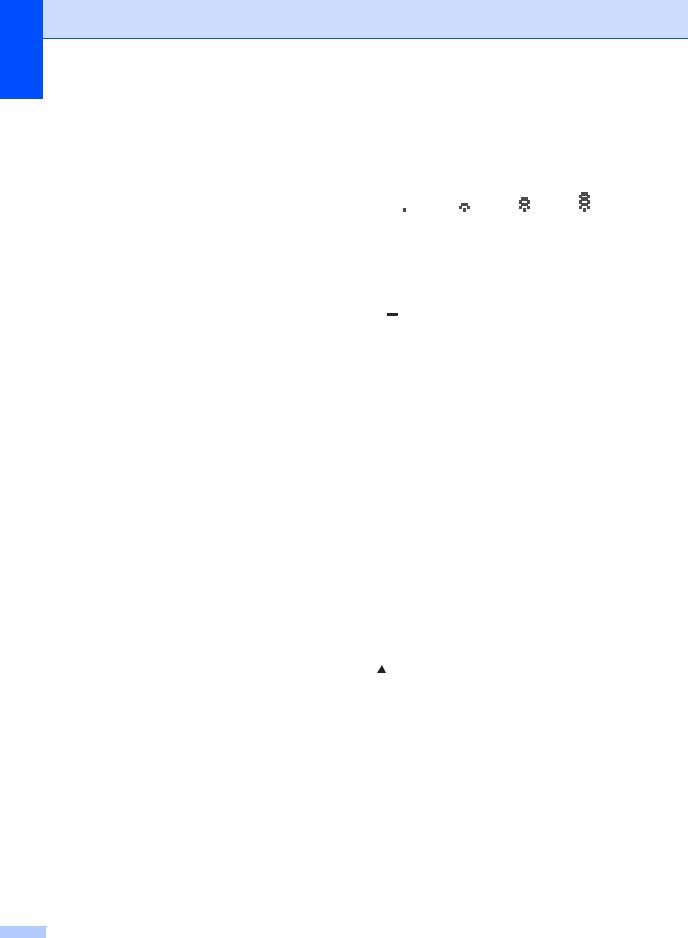
Chapter 1
1One Touch keys
These 4 keys give you instant access to 8 previously stored numbers.
Shift
Lets you access One Touch numbers 5 to 8 when held down.
2FAX keys: Hook
Press before dialing if you want to make sure a fax machine will answer, and then press Start. Also, press this key after you pick up the handset of an external telephone during the F/T ring (pseudo double-rings).
Redial/Pause
Redials the last number called. It also inserts a pause when programming quick dial numbers or when dialing a number manually.
Resolution
Sets the resolution when sending a fax.
3COPY keys: Options
You can quickly and easily choose temporary settings for copying.
Enlarge/Reduce
Reduces or enlarges copies.
Duplex
(For MFC-7460DN and MFC-7860DW)
You can choose Duplex to copy on both sides of the paper.
4PRINT keys:
Secure
(For MFC-7460DN and MFC-7860DW)
You can print data saved in the memory when you enter your four-digit password. (For details about using the Secure key, see the Software User's Guide.)
When using Secure Function Lock, you can switch restricted users by holding down Shift as you press Secure. (See Secure Function Lock 2.0 in Chapter 2 of the Advanced User's Guide.)
Job Cancel
Cancels a programmed print job and clears it from the machine’s memory. To cancel multiple print jobs, hold down this key until the LCD shows Job Cancel (All).
5LCD
Displays messages to help you set up and use your machine.
8 |
(MFC-7860DW)
In FAX mode and SCAN mode a four level indicator shows the current wireless signal strength if you are using a wireless connection.
0 |
Max |
6 Mode keys:
 FAX
FAX
Puts the machine in Fax mode.
 SCAN
SCAN
Puts the machine in Scan mode.
 COPY
COPY
Puts the machine in Copy mode.
7Menu keys: Clear
Deletes entered data or lets you cancel the current setting.
Menu
Lets you access the Menu to program your settings in this machine.
OK
Lets you store your settings in the machine.
Volume keys:
 d or c
d or c
Press to scroll backwards or forwards through menu selections. Press to change the volume when in fax or standby mode.
a or b
Press to scroll through the menus and options.
 Address Book
Address Book
Let you access speed dial numbers directly.
8Dial pad
Use these keys to dial telephone and fax numbers and as a keyboard for entering information into the machine.
9Start
Lets you start sending faxes or making copies.
10Stop/Exit
Stops an operation or exits from a menu.
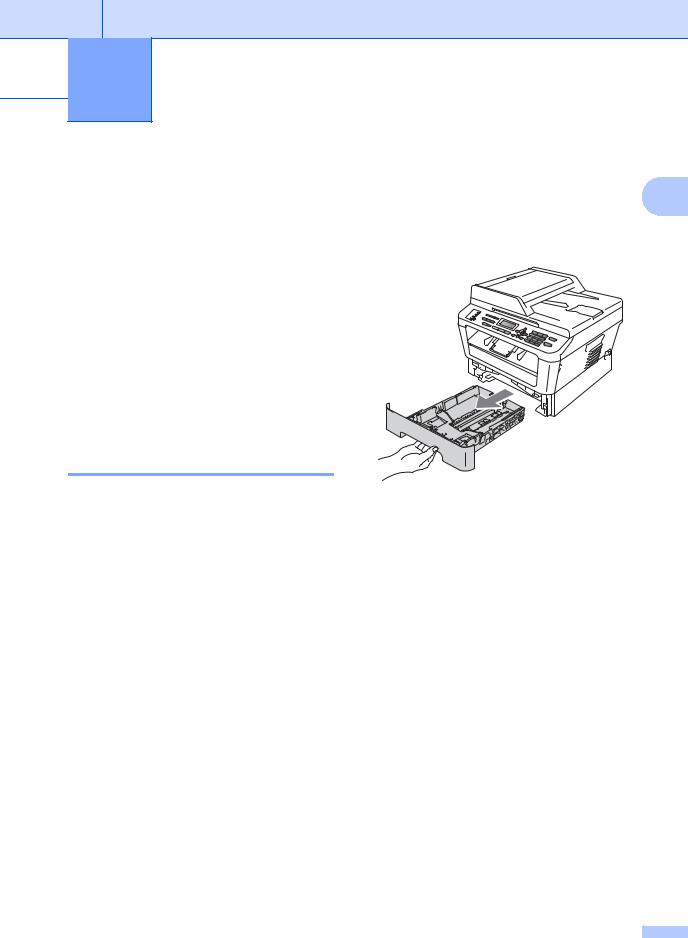
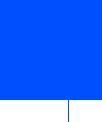 2 Loading paper
2 Loading paper
Loading paper and print media
The machine can feed paper from the standard paper tray or manual feed slot.
When you put paper into the paper tray, note the following:
If your application software supports paper size selection on the print menu, you can select it through the software. If your application software does not support it, you can set the paper size in the printer driver or by using the control panel buttons.
Loading paper in the standard paper tray
You can load up to 250 sheets. Paper can be loaded up to the maximum paper mark (b b b) on the sliding paper with guide. (For recommended paper to use, see Paper capacity of the paper trays on page 18.)
Printing on plain paper, thin paper or |
|
recycled paper from the standard |
2 |
paper tray |
a Pull the paper tray completely out of the machine.
9 |
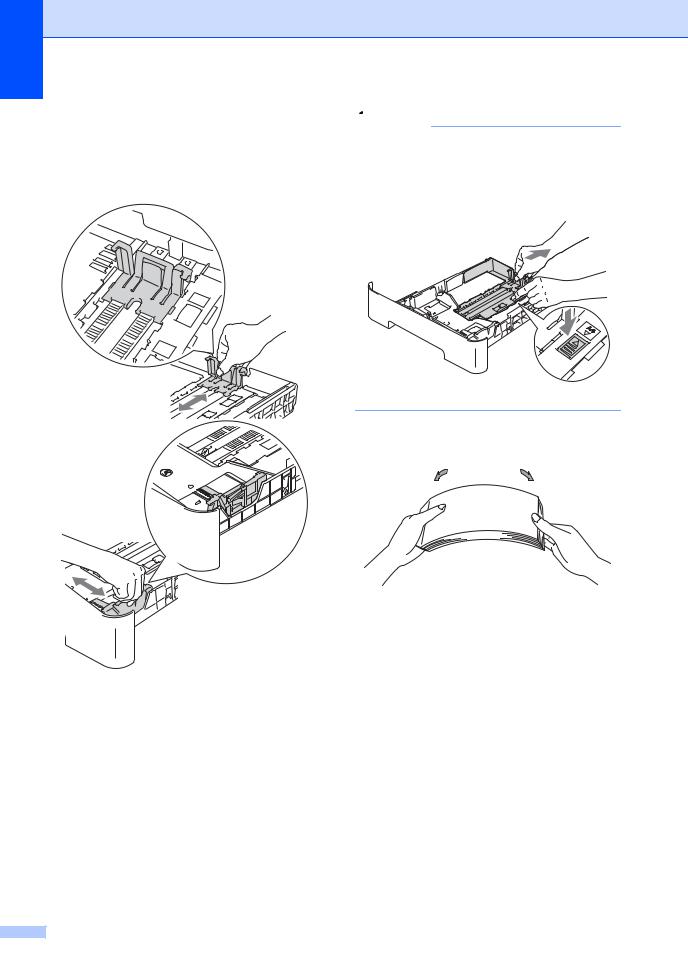
Chapter 2
b While pressing the green paper-guide release lever, slide the paper guides to fit the paper size you are loading in the tray. Make sure that the guides are firmly in the slots.
 Note
Note
For Legal or Folio size paper, press the release button in the bottom of the paper tray and then pull out the back of the paper tray.
c Fan the stack of paper well to avoid paper jams and misfeeds.
d Put paper in the tray and make sure:
The paper is below the maximum paper mark (b b b) (1).
Overfilling the paper tray will cause paper jams.
The side to be printed on must be face down.
The paper guides touch the sides of the paper so it will feed properly.
10
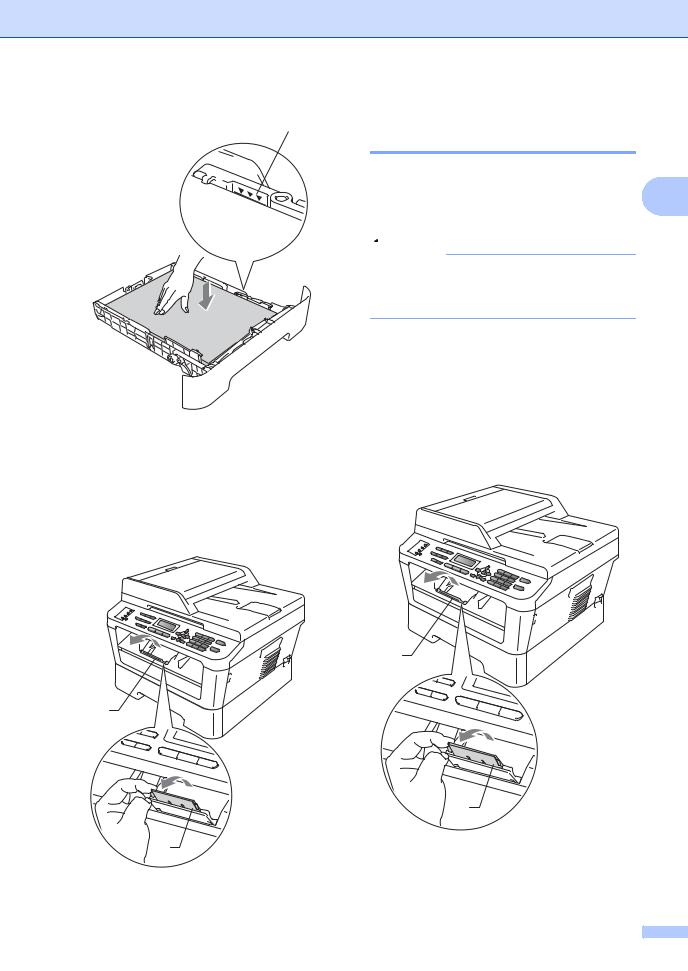
1
e Put the paper tray firmly back in the machine. Make sure that it is completely inserted into the machine.
f Unfold the support flap (1) to prevent paper from sliding off the face-down output tray.
Loading paper
Loading paper in the manual feed slot
You can load envelopes and special print
media one at a time into this slot. Use the 2 manual feed slot to print or copy on labels, envelopes or thicker paper.
 Note
Note
The machine automatically turns on the Manual Feed mode when you put paper in the manual feed slot.
Printing on plain paper, thin paper or recycled paper from the manual feed slot
a Unfold the support flap (1) to prevent paper from sliding off the face-down output tray, or remove each page as soon as it comes out of the machine.
1
1
11
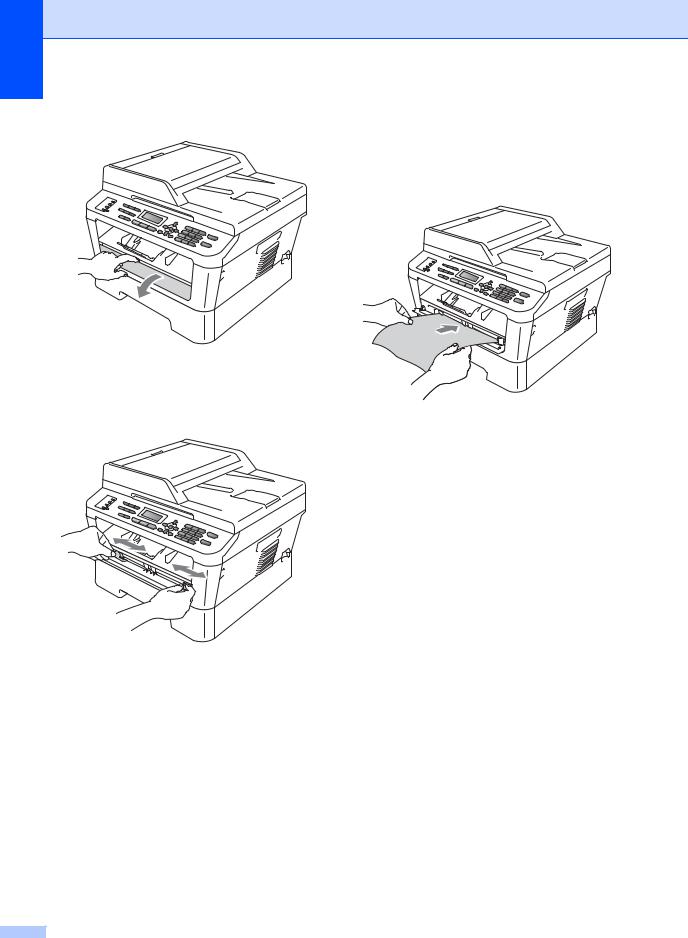
Chapter 2
b Open the manual feed slot cover.
c Using both hands, slide the manual feed slot paper guides to the width of the paper that you are going to use.
12
d Using both hands, put one sheet of paper in the manual feed slot until the front edge of the paper touches the paper feed roller. When you feel the machine pull in the paper, let go.
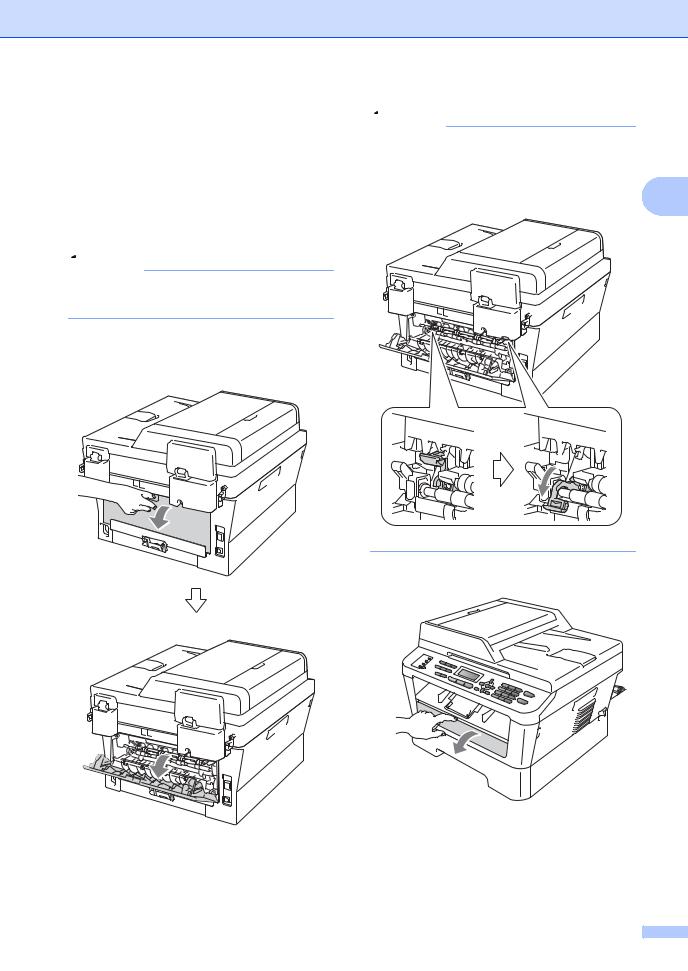
Printing on thick paper, bond paper, labels and envelopes
When the back output tray is pulled down, the machine has a straight paper path from the manual feed slot through to the back of the machine. Use this paper feed and output method when you want to print on thick paper, labels or envelopes.
 Note
Note
Remove each printed sheet or envelope immediately to prevent a paper jam.
a Open the back cover (back output tray).
Loading paper
 Note
Note
<For envelopes only> |
|
Pull down the two green levers, one on the |
|
left-hand side and one on the right-hand |
|
side, as shown in the following illustration. |
2 |
|
b Open the manual feed slot cover.
13
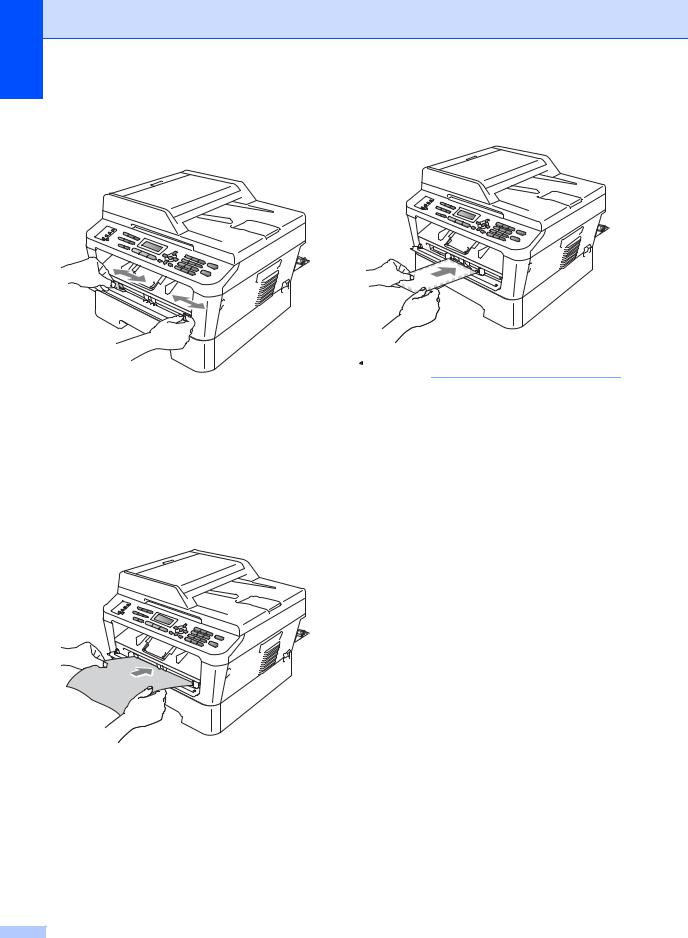
Chapter 2
c Using both hands, slide the manual feed slot paper guides to the width of the paper that you are going to use.
d Using both hands, put one sheet of paper or one envelope in the manual feed slot until the front edge of the paper or envelope touches the paper feed roller. When you feel the machine pull in the paper, let go.
 Note
Note
•Put the paper into the manual feed slot with the side to be printed face up.
•Make sure that the print media is straight and in the proper position on the manual feed slot. If it is not, the paper may not be fed properly, resulting in a skewed printout or a paper jam.
•Do not put more than one sheet of paper in the manual feed slot at any one time, as it may cause a jam.
•If you put any print media in the manual feed slot before the machine is in Ready mode, the print media may be ejected without being printed on.
•To easily remove a small printout from the output tray, lift up the scanner cover by using both hands as shown in the illustration.
14
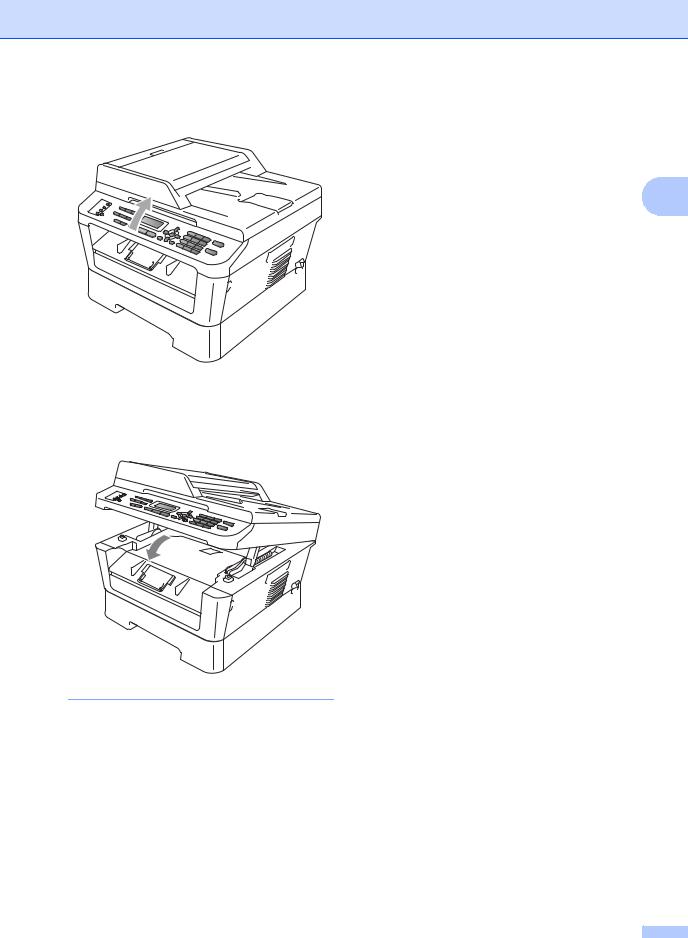
Loading paper
2
•You can still use the machine while the scanner cover is up. To close the scanner cover, push it down with both hands.
15
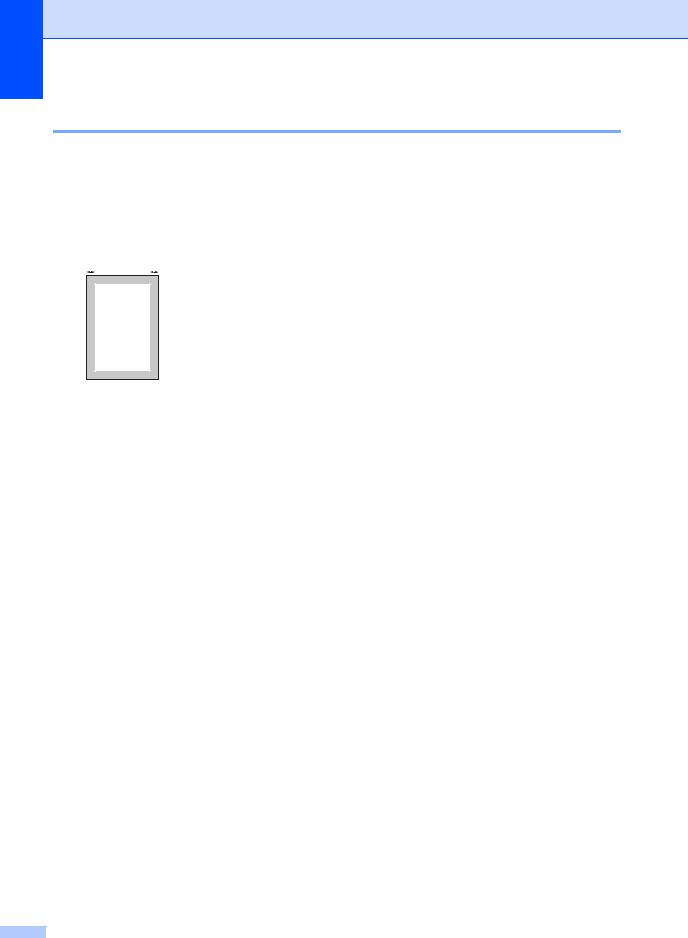
Chapter 2
Unscannable and unprintable areas
The figures below show maximum unscannable and unprintable areas. The unscannable and unprintable areas may vary depending on the paper size or settings in the application you are using.
2 2
1 
 1
1
Usage |
Document |
Top (1) |
Left (2) |
|
Size |
Bottom (1) |
Right (2) |
|
|
||
|
|
|
|
Fax (Send) |
Letter |
3 mm |
4 mm |
|
|
|
|
|
A4 |
3 mm |
3 mm |
|
|
|
|
Copy |
Letter |
3 mm |
4 mm |
|
|
|
|
*a single copy |
A4 |
3 mm |
3 mm |
or a 1 in 1 copy |
|
|
|
|
|
|
|
Scan |
Letter |
3 mm |
3 mm |
|
|
|
|
|
A4 |
3 mm |
3 mm |
|
|
|
|
Letter |
6 mm |
6.35 mm |
|
|
|
|
|
|
A4 |
6 mm |
6.35 mm |
|
|
|
|
16
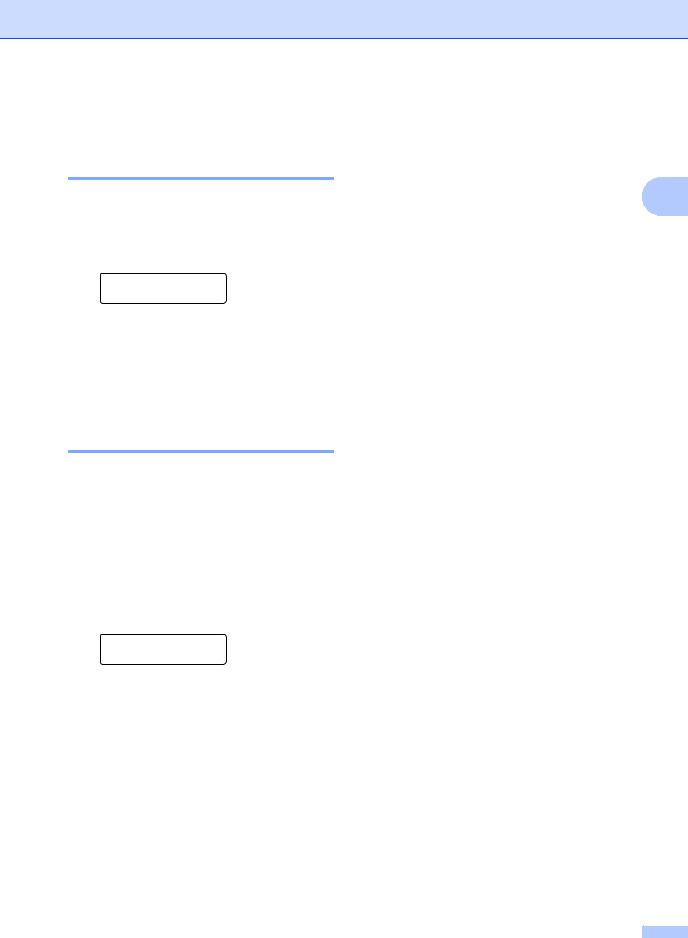
Paper settings
Paper Type
Set up the machine for the type of paper you are using. This will give you the best print quality.
a Press Menu, 1, 2, 1.
Paper 1.Paper Type
b Press a or b to choose Thin, Plain,
Thick, Thicker, Recycled Paper or Label.
Press OK.
c Press Stop/Exit.
Paper Size
You can use several different sizes of paper for printing copies: Letter, Legal, Executive, A4, A5, A5L, A6, B5, B6, and Folio.
When you change the size of paper in the tray, you will also need to change the setting for paper size at the same time so your machine can fit the document or an incoming fax on the page.
a Press Menu, 1, 2, 2.
Paper 2.Paper Size
b Press a or b to choose A4, Letter,
Legal, Executive, A5, A5 L, A6, B5, B6, or Folio.
Press OK.
c Press Stop/Exit.
Loading paper
Acceptable paper and other print media
Print quality may vary according to the type of |
2 |
paper you are using. |
You can use the following types of print media: thin paper, plain paper, thick paper, bond paper, recycled paper, labels or envelopes.
For best results, follow the instructions below:
DO NOT put different types of paper in the paper tray at the same time because it may cause paper jams or misfeeds.
For proper printing, you must choose the same paper size from your software application as the paper in the tray.
Avoid touching the printed surface of the paper immediately after printing.
Before you buy a lot of paper, test a small quantity to make sure the paper is suitable.
17
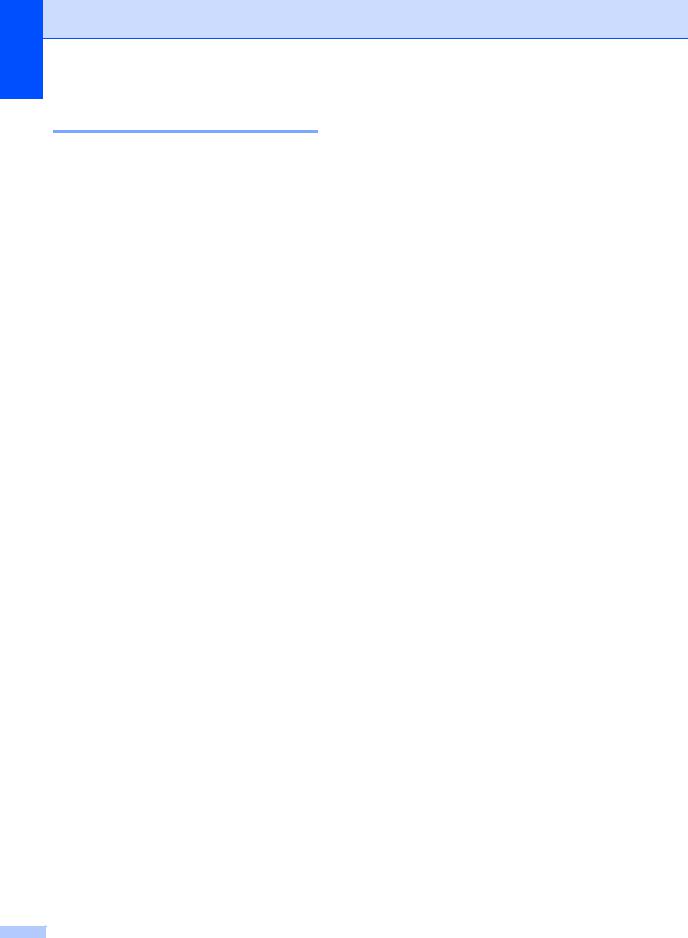
Chapter 2
Type and size of paper
The machine loads paper from the installed standard paper tray or manual feed slot.
The name for the paper trays in the printer driver in this Guide are as follows:
Tray and optional unit |
Name |
Standard paper tray |
Tray 1 |
|
|
Manual feed slot |
Manual |
|
|
Paper capacity of the paper trays
|
Paper size |
Paper types |
No. of sheets |
Paper Tray |
A4, Letter, B5, Executive, A5, |
Plain paper, Thin paper |
up to 250 (80 g/m2) |
(Tray 1) |
A5 (Long Edge), A6, B6, Folio 1, |
and Recycled paper |
|
|
Legal, 16K (195 mm x 270 mm), |
|
|
|
16K (184 mm x 260 mm), |
|
|
|
16K (197 mm x 273 mm) |
|
|
|
|
|
|
Manual feed slot |
Width: 76.2 to 216 mm |
Plain paper, Thin paper, |
Single sheet |
(Manual) |
Length: 116 to 406.4 mm |
Thick paper, |
(80 g/m2) |
|
|
Bond paper, |
|
|
|
Recycled paper, |
|
|
|
Envelopes and Labels |
|
|
|
|
|
1 Folio size is 215.9 mm x 330.2 mm |
|
|
|
Recommended paper specifications
The following paper specifications are suitable for this machine.
Basis weight |
75-90 g/m2 |
Thickness |
80-110 m |
|
|
Roughness |
Higher than 20 sec. |
|
|
Stiffness |
90-150 cm3/100 |
Grain direction |
Long grain |
|
|
Volume resistivity |
10e9-10e11 ohm |
Surface resistivity |
10e9-10e12 ohm-cm |
Filler |
CaCO3 (Neutral) |
Ash content |
Below 23 wt% |
|
|
Brightness |
Higher than 80% |
|
|
Opacity |
Higher than 85% |
|
|
Use paper made for plain paper copying.
Use paper that is 75 to 90 g/m2.
Use long grain paper with a neutral Ph value, and a moisture content of approx. 5%.
This machine can use recycled paper that meets DIN 19309 specifications.
18
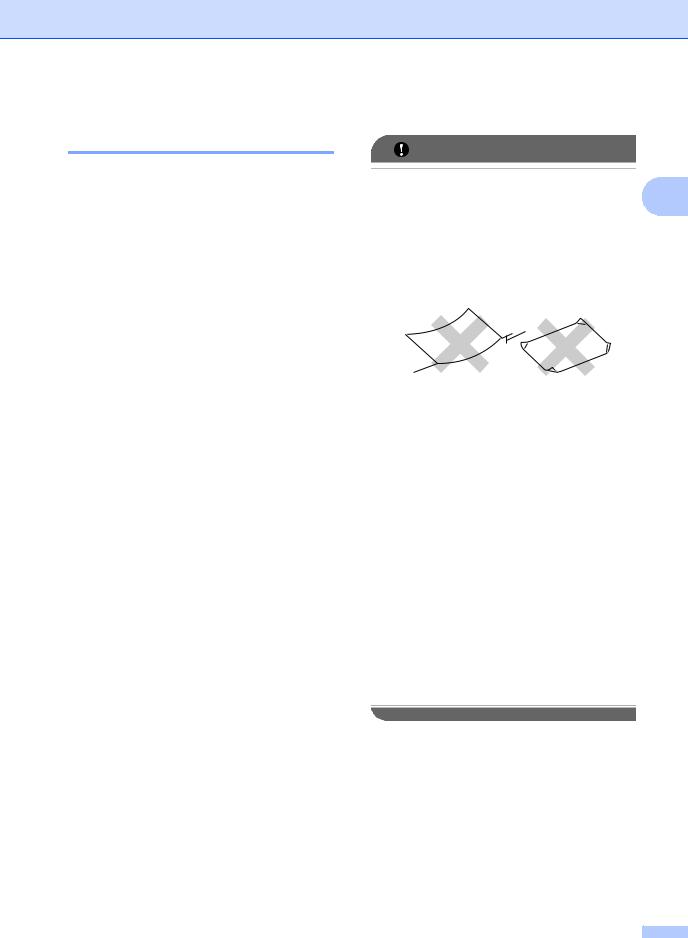
Handling and using special paper
The machine is designed to work well with most types of xerographic and bond paper. However, some paper variables may have an effect on print quality or handling reliability. Always test samples of paper before purchasing to ensure desirable performance. Store paper in its original packaging and keep it sealed. Keep the paper flat and away from moisture, direct sunlight and heat.
Some important guidelines when selecting paper are:
DO NOT use inkjet paper because it may cause a paper jam or damage your machine.
Preprinted paper must use ink that can withstand the temperature of the machine’s fusing process 392 degrees Fahrenheit (200 degrees centigrade).
If you use bond paper, paper having a rough surface or paper that is wrinkled or creased, the paper may exhibit degraded performance.
Loading paper
Types of paper to avoid
IMPORTANT
Some types of paper may not perform well |
|
|
or may cause damage to your machine. |
2 |
|
DO NOT use paper: |
||
|
•that is highly textured
•that is extremely smooth or shiny
•that is curled or warped
1
1
1A curl of 2 mm or greater may cause jams to occur.
•that is coated or has a chemical finish
•that is damaged, creased or folded
•that exceeds the recommended weight specification in this guide
•with tabs and staples
•with letterheads using low temperature dyes or thermography
•that is multipart or carbonless
•that is designed for inkjet printing
If you use any of the types of paper listed above, they may damage your machine. This damage is not covered under any Brother warranty or service agreement.
19

Chapter 2
Envelopes
Most envelopes designed for laser printers will be suitable for your machine. However, some envelopes may have feed and printquality problems because of the way they have been made. A suitable envelope should have edges with straight, well-creased folds and the leading edge should not be thicker than two sheets of paper. The envelope should lie flat and not be of baggy or flimsy construction. You should buy quality envelopes from a supplier who understands that you will be using the envelopes in a laser machine.
Envelopes can be fed from the manual feed slot one at a time. We recommend that you print a test envelope to make sure the print results are what you want before you print or purchase a large quantity of envelopes.
Types of envelopes to avoid
IMPORTANT
DO NOT use envelopes:
•that are damaged, curled, wrinkled or an unusual shape
•that are extremely shiny or textured
•with clasps, staples, snaps or tie strings
•with self-adhesive closures
•that are of a baggy construction
•that are not sharply creased
•that are embossed (have raised writing on them)
•that were previously printed by a laser machine
•that are pre-printed on the inside
•that cannot be arranged neatly when stacked
•that are made of paper that weighs more than the paper weight specifications for the machine
20
•with edges that are not straight or consistently square
•with windows, holes, cut-outs or perforations
•with glue on surface as shown in figure below
•with double flaps as shown in figure below
•with sealing flaps that are not folded down when purchased
•with sealing flaps as shown in figure below
•with each side folded as shown in figure below
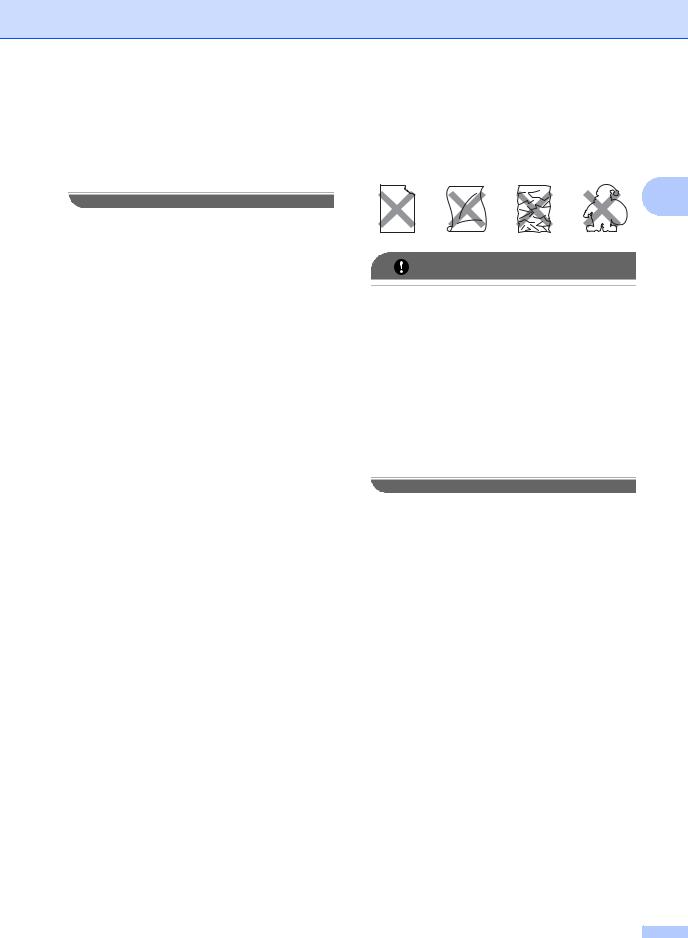
If you use any of the types of envelopes listed above, they may damage your machine. This damage may not be covered under any Brother warranty or service agreement.
Labels
The machine will print on most types of labels designed for use with a laser machine. Labels should have an adhesive that is acrylic-based since this material is more stable at the high temperatures in the fuser unit. Adhesives should not come in contact with any part of the machine, because the label stock may stick to the drum unit or rollers and cause jams and print quality problems. No adhesive should be exposed between the labels. Labels should be arranged so that they cover the entire length and width of the sheet. Using labels with spaces may result in labels peeling off and causing serious jams or print problems.
All labels used in this machine must be able to withstand a temperature of 392 degrees Fahrenheit (200 degrees centigrade) for a period of 0.1 seconds.
Do not feed a label sheet through the machine more than one time.
Loading paper
Types of labels to avoid
Do not use labels that are damaged, curled, wrinkled or an unusual shape.
2
IMPORTANT
•Avoid feeding labels with the carrier sheet exposed because your machine will be damaged.
•Label sheets should not exceed the paper weight specifications described in this User’s Guide. Labels exceeding this specification may not feed or print properly and may cause damage to your machine.
•DO NOT reuse or insert labels that have previously been used or are missing few labels on the sheet.
21
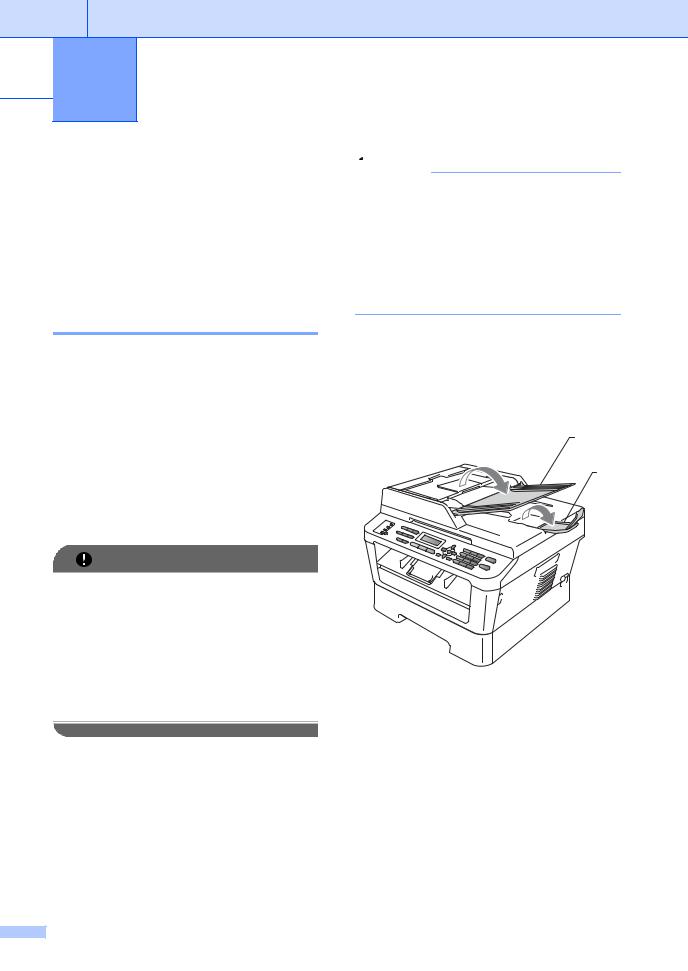
 3 Loading documents
3 Loading documents
How to load documents
You can send a fax, make copies, and scan from the ADF (Automatic Document Feeder) and the scanner glass.
Using the automatic document feeder (ADF)
The ADF can hold up to 35 pages and feeds each sheet individually. Use standard
80 g/m2 paper and always fan the pages before putting them in the ADF.
Document Sizes Supported
Length: |
147.3 to 355.6 mm |
Width: |
147.3 to 215.9 mm |
Weight: |
64 to 90 g/m2 |
IMPORTANT
•DO NOT use paper that is curled, wrinkled, folded, ripped, stapled, paperclipped, pasted or taped.
•DO NOT use cardboard, newspaper or fabric.
•To avoid damaging your machine while using the ADF, DO NOT pull on the document while it is feeding.
 Note
Note
•To scan documents that are not suitable for the ADF, see Using the scanner glass on page 23.
•It is easier to use the ADF if you are loading a multiple page document.
•Make sure documents with correction fluid or written with ink are completely dry.
How to load documents
a Lift up and unfold the ADF document output support flap (1). Unfold the ADF document support (2).
(2)
(1)
b Fan the pages well.
22
